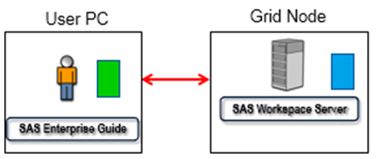SAS 9.4 has been out for some time now, and all SAS grid computing enthusiasts know that one of the new features is that SAS Workspace Server processes can be directly launched on the grid. (See The Top Four User-Requested Grid Features Delivered with SAS® Grid Manager 9.4.)
What does this mean? Well, in a sentence, the object spawner submits the command to start a workspace server to LSF, which in turn decides which server best fits the request and directly starts the workspace server.
What's different than before? SAS Grid Manager for SAS 9.3 already has a grid algorithm to use LSF to balance server workloads. With the SAS 9.3 load balancing algorithm, the object spawner delegates to LSF the responsibility to choose the best host, but keeps the role to start the actual server process.
With the SAS 9.4 grid load-balancing algorithm with grid-launched workspace servers, the object spawner delegates both responsibilities to LSF: to choose the best host and to actually start the process.
Here is a simple table that summarizes load-balancing and server processes across releases: 
How does this change affect my applications?
Let's take SAS Enterprise guide as a sample. You go from this:
to this:
Advantages for grid-launched workspace servers
There are several advantages to using the SAS Grid Manager to launch workspace servers beyond the ability to apply policy. For SAS 9.4, this change eliminates:
- GRIDWORK and RMTWORK libraries: there is only SASWORK.
- a grid server process: there is now only a SAS workspace server process.
- confusion when trying to monitor the user’s SAS process: now the same SAS process can be viewed from both SAS Management Console and Platform RTM for SAS.
Have you already used this new feature? Do you have any hint to share?



5 Comments
Thanks for the post.
Definitely useful and will definitely ease things up.
However, I have a question that I'm finding difficult to get a definitive answer to. If you have a grid of say 10 nodes, does the Object Spawner sit on the Grid Control Server only or on each node?
Assuming workspace servers are grid-launched.
Henry, thanks for reading the post.
Enabling grid-launched SAS workspace servers simplifies the deployment of the Object Spawner – only one Object Spawner is technically required for the entire grid.
We no longer need an Object Spawner running on each machine to start new SAS processes – LSF can handle that task now.
However, we recommend running at least 2 Object Spawners (on different hosts) to support high availability in case one goes down unexpectedly.
It is indeed one of best features of 9.4 Going from 9.3, using grid load balancing was helpful but this is the ultimate way to go. No more Obj spawner sessions launching grid jobs. One more advantage I believe is that EG connections to grid will be much faster without the additional interaction between the spawner and lsf.
Krish Putta
Thanks Krish for your comment. I agree that this new feature will really improve end users experience and simplify administration.
Grid infrastructure always adds some delay in server start up time, so even with the new grid launched workspace servers you will have to wait a few seconds before a session starts. If you really need a real-time start up you can always use one of the other load balancing algorithms ( see the SAS(R) 9.4 Intelligence Platform: Application Server Administration Guide for more info on the topic).
If you want to discover in-depth information and more on EG and grid, be sure to attend the upcoming SGF 2014, I'll be presenting a paper titled "Effective Usage of SAS® Enterprise Guide® in a SAS® 9.4 Grid Manager Environment"
Enabling grid-launched SAS workspace servers simplifies the deployment of the Object Spawner – only one Object Spawner is technically required for the entire grid.